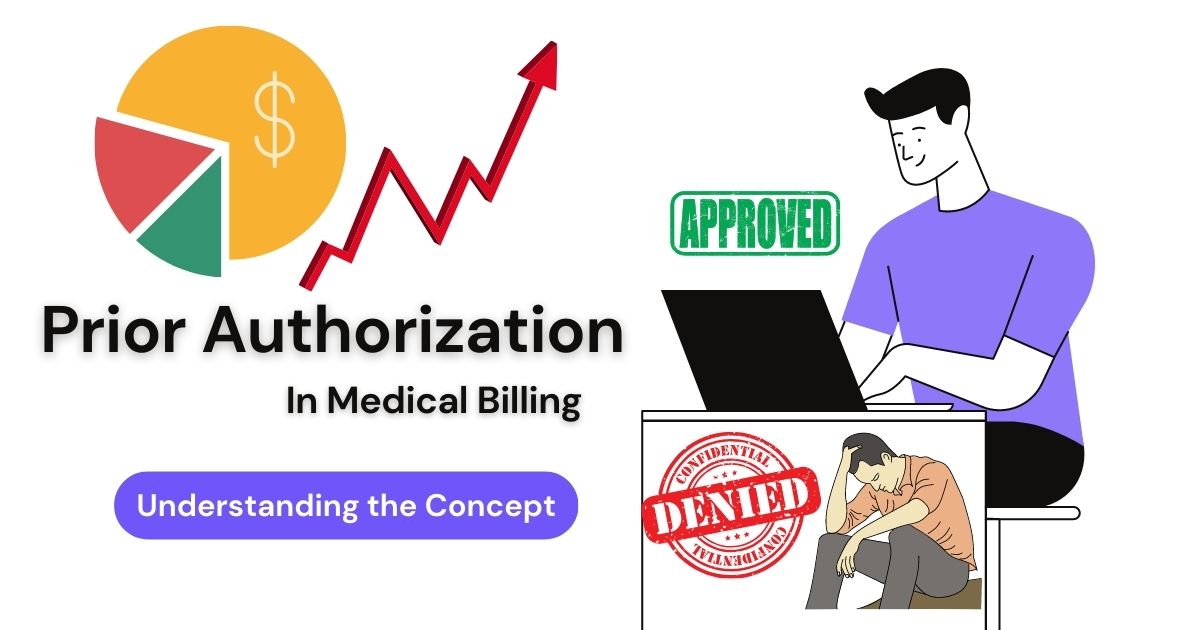Introduction: What is Prior Authorization in Medical Billing?
In the complex world of medical billing, one term that often comes up is “Prior Authorization.” Whether you’re a patient, healthcare provider, or an insurance company, understanding the ins and outs of prior authorization is crucial. In this comprehensive guide, we’ll delve into the depths of this process, exploring what it is, how it works, and why it matters. So, let’s begin this journey together to demystify prior authorization in medical billing.
1. Defining Prior Authorization
Prior Authorization, also known as pre-authorization or pre-certification, is a process that requires healthcare providers to obtain approval from insurance companies before performing certain medical procedures or prescribing specific medications. It’s essentially a safeguard that ensures the medical necessity and appropriateness of the proposed treatment, as well as determines whether the insurance company will cover the cost.
2. Why is Prior Authorization Necessary?
The primary goal of prior authorization is to control healthcare costs and prevent unnecessary or inappropriate medical services. Insurance companies use this process to review the requested services or medications and assess if they align with the patient’s health condition and meet established guidelines.
Prior authorization helps strike a balance between providing adequate medical care and managing expenses for both insurance providers and patients. While it may sometimes cause delays in treatment, it’s a vital step in maintaining healthcare affordability.
3. Common Procedures and Medications Requiring Prior Authorization
The range of medical services and medications subject to prior authorization can vary from one insurance plan to another. However, certain categories are more commonly subjected to this process, including:
• High-Cost Treatments: Procedures like surgeries, MRIs, CT scans, and chemotherapy may require prior authorization due to their significant financial impact.
• Specialty Medications: Expensive specialty drugs used to treat complex conditions such as cancer, autoimmune disorders, and rare diseases often need prior authorization.
• Experimental or Investigational Treatments: New and experimental treatments that lack sufficient clinical data may need prior approval to ensure they meet medical standards.
• High-Risk Medications: Medications with potential risks or potential for abuse may require prior authorization for controlled prescribing.
4. The Prior Authorization Process
The prior authorization process typically involves the following steps:
a. Prescribing Decision: The healthcare provider evaluates the patient’s condition and decides on the most suitable treatment or medication.
b. Verification of Coverage: The provider’s office contacts the patient’s insurance company to check if the proposed service or medication requires prior authorization and whether it is covered by the policy.
c. Submission of Request: If prior authorization is necessary, the provider submits a formal request to the insurance company, including relevant medical records, test results, and a justification for the proposed treatment.
d. Review and Decision: The insurance company’s medical review team assesses the request, evaluating medical necessity and adherence to policy guidelines. This process can take a few days to several weeks, depending on the urgency of the case.
e. Approval or Denial: The insurance company informs the healthcare provider and the patient of the prior authorization decision. If approved, the provider can proceed with the recommended treatment. In case of denial, the patient and provider may appeal the decision or explore alternative options.
5. Challenges with Prior Authorization
While prior authorization serves its purpose, it’s not without its challenges:
a. Administrative Burden: The prior authorization process can be time-consuming and burdensome for healthcare providers, diverting their attention from patient care.
b. Delayed Care: Waiting for approval can cause delays in treatment, potentially affecting patient outcomes, especially in urgent or critical cases.
c. Complex Policies: Insurance companies may have intricate and ever-changing prior authorization policies, making it difficult for providers to keep up with the requirements.
d. Appeals and Denials: Providers often face denials, necessitating appeals, which further prolong the treatment process and may lead to frustration for patients and caregivers.
6. Tips for Navigating Prior Authorization Successfully
Navigating the prior authorization maze requires a strategic approach:
a. Stay Informed: Healthcare providers should regularly update themselves on insurance companies’ prior authorization guidelines to ensure accurate submissions.
b. Detailed Documentation: Comprehensive documentation of the patient’s medical history and the necessity of the proposed treatment can strengthen the prior authorization request.
c. Open Communication: Maintaining transparent communication with patients about the prior authorization process helps manage expectations and reduce anxiety.
d. Expedite Urgent Cases: In emergency situations, providers can request expedited reviews to accelerate the approval process.
Debunking Prior Authorization Myths in Medical Billing
This crucial step in the healthcare process can sometimes be misunderstood and lead to various myths circulating among healthcare providers and patients alike. We will debunk common myths, and shedding light on its importance in the medical billing landscape.
Myth #1: Prior Authorization is a Time-Consuming Process
One prevalent myth surrounding prior authorization is that it is an overly time-consuming process, causing delays in patient care. While it is true that prior authorization involves some paperwork and communication with insurance companies, advancements in technology have streamlined the process significantly.
Many healthcare providers now utilize electronic prior authorization (ePA) systems that allow for faster submissions and responses. These ePA systems can often provide real-time approvals, reducing the wait time for patients and ensuring timely access to necessary treatments.
1. The Importance of Prior Authorization
Some critics argue that prior authorization only adds unnecessary complexity to the healthcare system, but its importance should not be underestimated. Prior authorization serves several essential purposes:
1.1 Ensuring Appropriate Use of Medical Services
Prior authorization helps prevent unnecessary or potentially harmful medical services. By requiring providers to seek approval beforehand, insurance companies can evaluate whether a proposed treatment aligns with evidence-based guidelines, ensuring patients receive the most appropriate care.
1.2 Controlling Healthcare Costs
In an era where healthcare costs are skyrocketing, controlling expenses is critical. Prior authorization allows insurance companies to manage healthcare spending effectively. By evaluating the necessity and efficacy of treatments, insurers can allocate their resources wisely.
1.3 Safeguarding Against Fraud and Abuse
Another essential function of prior authorization is to protect against fraud and abuse. Unfortunately, the healthcare industry is not immune to fraudulent activities. Prior authorization acts as a safeguard, ensuring that treatments and medications are legitimate and medically necessary.
2. Myth #2: Prior Authorization is Always Denied
One of the most common myths is that prior authorization requests are routinely denied. While denials can happen, they are not as frequent as some may believe. The key to a successful prior authorization request lies in proper preparation and accurate documentation.
When submitting a prior authorization request, healthcare providers should ensure that all necessary information, such as medical records, diagnostic reports, and treatment plans, is included. By providing a comprehensive package, the chances of approval increase significantly.
3. Tips for a Smooth Prior Authorization Process
Navigating the prior authorization process can be challenging, but with the right approach, healthcare providers can enhance their chances of success. Here are some valuable tips to streamline the process:
3.1 Know Your Insurance Plan
Each insurance plan may have different prior authorization requirements. It is crucial for healthcare providers and their staff to familiarize themselves with the specific guidelines and procedures of the insurance companies they frequently work with.
3.2 Communicate Clearly with Patients
Effective communication with patients is vital throughout the prior authorization process. Patients should be informed about the need for prior authorization, the expected timeline, and any potential out-of-pocket expenses. Clear communication can reduce patient frustration and anxiety.
3.3 Leverage Technology
As mentioned earlier, electronic prior authorization systems can significantly speed up the process. Healthcare providers should embrace technology and leverage electronic platforms to submit and track prior authorization requests.
4. Myth #3: Prior Authorization is only required for Expensive Treatments
Some people mistakenly believe that prior authorization is solely needed for expensive treatments or medications. However, the cost of a treatment is not the sole determinant for requiring prior authorization. Certain medical services or medications, regardless of their price, may necessitate approval due to safety concerns, potential interactions, or alternative treatment options.
5. Prior Authorization and Patient Advocacy
While the prior authorization process can seem daunting, it is essential to remember that it ultimately benefits the patient. It ensures that patients receive appropriate and effective care while controlling healthcare costs. As such, healthcare providers should advocate for their patients during the prior authorization process, helping them navigate the complexities and secure necessary approvals.
6. The Role of Technology in Streamlining Prior Authorization
Advancements in technology have played a pivotal role in improving the prior authorization process. Electronic prior authorization systems, artificial intelligence, and automated documentation processes have all contributed to making the process more efficient and reducing administrative burdens.
7. Addressing Prior Authorization Challenges
Despite the progress made in streamlining prior authorization, challenges still persist. Some of the common challenges include:
7.1 Inconsistent Prior Authorization Requirements
Different insurance companies may have varying requirements, leading to inconsistencies and confusion for healthcare providers. Efforts should be made to standardize the process and create more uniform guidelines.
7.2 Administrative Burden
The administrative workload associated with prior authorization can be overwhelming for healthcare providers and their staff. Implementing efficient electronic systems and delegating responsibilities can alleviate this burden.
8. The Future of Prior Authorization
As healthcare and technology continue to evolve, the future of prior authorization holds promise. Further integration of electronic systems, increased automation, and data-driven decision-making will likely enhance the process’s efficiency and accuracy.
Navigating the Maze of Insurance Coverage Limits
As the medical landscape continues to evolve, one aspect that often perplexes both healthcare providers and patients alike is insurance coverage limits for prior authorization in medical billing. Understanding these limits is crucial for ensuring smooth and efficient reimbursement processes and avoiding potential pitfalls that may arise during the billing cycle. In this comprehensive guide, we’ll shed light on what insurance coverage limits for prior authorization are, their significance, and how they impact medical billing procedures.
1. Demystifying Prior Authorization
Prior authorization, also known as pre-approval or preauthorization, is the process through which healthcare providers obtain approval from insurance companies before rendering specific medical services or treatments. The primary purpose of prior authorization is to ensure that the proposed treatment is medically necessary and cost-effective, thereby controlling healthcare expenses.
2. The Role of Insurance Coverage Limits
Insurance coverage limits, or simply coverage limits, refer to the maximum amount an insurance policy will pay for a specific medical service or treatment. These limits can vary depending on the insurance plan, the type of service, and the healthcare provider. It’s essential to understand these limits to avoid billing issues and unexpected out-of-pocket expenses for patients.
3. Different Types of Insurance Coverage Limits
A) Service-Specific Limits: Some insurance plans may impose limits on specific services, such as physical therapy sessions, mental health consultations, or diagnostic tests. It’s crucial for healthcare providers to be aware of these limitations to prevent claim denials and ensure appropriate billing.
B) Time-Based Limits: Time-based limits dictate the maximum duration or frequency for which certain treatments or services are covered. For example, an insurance plan may cover physical therapy sessions for up to 12 weeks or limit the number of counseling sessions per year.
C) Lifetime Limits: Lifetime limits specify the maximum amount an insurance plan will pay for a particular service or treatment over a patient’s lifetime. These limits were more common in the past, but some older insurance plans may still have them in place.
4. The Importance of Prior Authorization for Patients
For patients, prior authorization is essential as it helps them understand whether a particular medical service or treatment is covered by their insurance plan. This information empowers patients to make informed decisions about their healthcare, especially when it comes to elective or costly procedures.
5. The Impact of Coverage Limits on Medical Billing
A) Claim Rejections and Denials: Failure to adhere to coverage limits can lead to claim rejections or denials, resulting in delayed payments and administrative headaches for healthcare providers.
B) Patient Responsibility: When medical services exceed the coverage limits, patients may be responsible for paying the difference out-of-pocket. This can create financial burdens and impact patient satisfaction.
6. Strategies for Navigating Insurance Coverage Limits
A) Verify Coverage and Obtain Prior Authorization: Before providing any medical service, healthcare providers must verify the patient’s insurance coverage and obtain prior authorization if required. Clear communication with both patients and insurance companies is vital to ensure a smooth process.
B) Appealing Denials: If a claim is denied due to coverage limits, healthcare providers have the option to appeal the decision, providing additional evidence to support the medical necessity of the service.
7. Understanding Medical Necessity
The concept of medical necessity plays a significant role in determining whether a particular service is covered by insurance. Insurance companies evaluate medical necessity based on the patient’s condition, the recommended treatment, and the available alternatives.
8. Staying Updated with Insurance Policies
Insurance policies and coverage limits can change over time. Therefore, it’s crucial for healthcare providers to stay updated with the latest information to avoid billing discrepancies and optimize the reimbursement process.
9. The Need for Transparency and Patient Education
Transparency in explaining insurance coverage limits and prior authorization processes to patients is vital for building trust and reducing confusion. Patient education can help prevent surprises related to insurance coverage and billing.
10. The Future of Insurance Coverage Limits
As the healthcare industry continues to evolve, insurance coverage limits may undergo further changes. Understanding and adapting to these changes will be key for healthcare providers to maintain efficient billing practices.
Conclusion: Empowering Providers and Patients Alike
Prior authorization is an essential process in medical billing, serving as a safeguard against unnecessary medical expenses. While it can present challenges, understanding the process and adhering to insurance guidelines can lead to smoother approvals. As healthcare continues to evolve, finding ways to streamline the prior authorization process will be crucial in delivering efficient and effective patient care.
So, whether you’re a patient or a healthcare provider, knowing the intricacies of prior authorization empowers you to make informed decisions, ensuring that the best possible care is provided while managing healthcare costs responsibly.
Insurance coverage limits for prior authorization in medical billing may seem complex, but they are an essential aspect of the healthcare ecosystem. By understanding these limits and adopting effective strategies for navigating them, healthcare providers can streamline their billing processes and provide better care to their patients. Transparency and patient education are crucial in empowering patients to make informed decisions about their healthcare options. As we look to the future, staying informed and adaptable will be the key to success in the ever-changing landscape of medical billing and insurance coverage.



